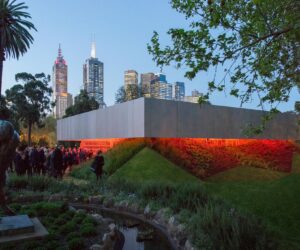Pritzker Prize-winning Japanese architect comes to Sydney
Marking the architect’s first Australian project, Shigeru Ban has designed two architectural installations to be presented at Sherman Contemporary Art Foundation (SCAF) Courtyard Garden and Gallery Space from 25 March until 1 July 2017. Shigeru Ban’s installations also represent the final project to be presented by SCAF before the Foundation evolves into a centre for the exchange of ideas on contemporary culture.
“Shigeru Ban’s 2017 SCAF project echoes the Foundation’s inaugural 2008 Ai Weiwei Project at a number of significant levels. Born in Japan and China respectively in 1957 – these creative titans share a number of preoccupations, which resonate strongly with me personally. Via art & architecture they both actively engage with society at large, focusing on the dispossessed, the homeless and the disempowered. Their methodologies may differ; their goals clearly intersect. With this exhibition, SCAF will bookend its ten years as a commissioning institution with two of the cultural world’s internationally renowned elder statesmen” said Dr Gene Sherman, Executive Director, SCAF.
SCAF’s exhibition will shine a spotlight on Japanese architect Ban’s pioneering and resourceful designs and importantly his dedication to humanitarian efforts around the world.
For the first time SCAF’s interior and exterior spaces will feature the work of a single practitioner. The Courtyard Garden installation will feature two of Shigeru Ban’s signature disaster relief shelters; one of his first from Kobe (1995) positioned in comparison to his latest disaster relief design for the Ecuador earthquake (2016).
The interior gallery presentation will highlight key “stepping stones” from Shigeru Ban Architects’ 2000 Japan Pavilion in Hannover, Germany, to the celebrated 2013 Cardboard Cathedral in Christchurch, New Zealand. An immersive scaled version of the Cardboard Cathedral will feature as centerpiece, complemented by a four-metre scale model of Ban’s Japan Pavilion, and selected components of his work.
Temporary architecture, in disaster zones, is Ban’s calling card. For over 20 years, the 2014 winner of the Pritzker Prize, architecture’s Nobel, has best been known for his humanitarian work. From Rwanda to Japan to Nepal he has turned cheap, locally sourced materials—sometimes even debris—into disaster-relief housing that “house both the body and spirit”.
Ban’s simple and dignified architectural works have provided relief to victims of mass displacement, tsunamis, earthquakes, and mega disasters, both natural and manmade. His long history of humanitarian design started with his UN consultancy work in the 1995 Rwanda conflict, where he first proposed shelters made from paper tubes. Over time, he carried his paper tube concept to other disaster relief projects from a “Paper Log House” designed for the community in Kobe to temporary housing for the victims of the 2011 Onagawa earthquake. His creative use of common and often unconventional materials in disaster relief projects expanded to include bamboo, fabric, paper, and recycled composites.
Shigeru Ban comments: “Architects mostly work for privileged people, people who have money and power. Power and money are invisible, so people hire us to visualise their power and money by making monumental architecture. I love to make monuments, too, but I thought perhaps we can use our experience and knowledge more for the general public, even for those who have lost their houses in natural disasters.”
Aside from shelter housing, Shigeru Ban Architects have created major cultural institutions including Centre Pompidou-Metz, France and soon-to-be-opened Mount Fuji World Heritage Centre, Japan; the Cité musicale de l’Île Seguin, Paris, France; and various other commercial projects, academic buildings (Seikei University Library, Japan), private residences and exhibitions.
Shigeru Ban will be in Sydney Friday 24 March ahead of presenting the keynote address for this year’s Asia Pacific Architecture Forum Symposium that evening in Brisbane and returning to Sydney on Saturday 25 March to present a ticketed public talk at the Sydney Opera House prior to the opening of his exhibition at SCAF that evening.
Exhibition details: The inventive work of Shigeru Ban: SCAF Projects 34 & 35 will be on display at Sherman Contemporary Art Foundation (SCAF), 25 March –1 July 2017, 16–20 Goodhope Street, Paddington, Sydney NSW 2021. Access is free of charge and open to the public Wednesday to Saturday 11am to 5pm. For further details visit: sherman-scaf.org.au.
Asia Pacific Architecture Forum: Shigeru Ban will present the keynote talk at the ArchitectureAP Symposium on Friday 24 March. Details available here.



